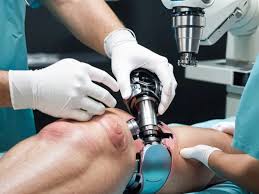Artificial Intelligence and Robotic surgery in Orthopaedics
Abstract
Artificial intelligence (AI), first proposed by Prof. John McCarthy in 1956, aims to reproduce human intelligence using computers. Machine learning (ML) is a form of AI that uses computational algorithms that learn and improve with experience.[1] Artificial intelligence is improving the surgical skills of orthopaedic surgeons by improving their clinical decisions. Technology can improve the surgical skills of the doctors. It can also improve the healthcare system. By this, the computer uses neural networks and learning models to learn to distinguish patterns directly from data and learns on its own to select features to classify the input data. To put it simply, using AI and machine learning algorithms, the surgeon can make good use of a huge amount of data. This allows them to comprehend, predict, act, and learn. (2)
Downloads
References
2. Houserman DJ, Berend KR, Lombardi AV Jr, Duhaime EP, Jain A, Crawford DA: The viability of an artificial intelligence/machine learning prediction model to determine candidates for knee arthroplasty. J Arthroplasty. 2022, S0883-5403:00394-1. 10.1016/j.arth.2022.04.003
3. Wu D, Liu X, Zhang Y, Chen J, Tang P, Chai W: Research and application of artificial intelligence based three-dimensional preoperative planning system for total hip arthroplasty (Article in Chinese). Zhongguo Xiu Fu Chong Jian Wai Ke Za Zhi. 2020, 34:1077-84. 10.7507/1002-1892.202005007
4. Gyftopoulos S, Lin D, Knoll F, Doshi AM, Rodrigues TC, Recht MP. Artificial intelligence in musculoskeletal imaging: current status and future directions. AJR Am J Roentgenol 2019;213:506–513. doi: 10.2214/AJR.19.21117.
5. Kurmis AP, Ianunzio JR: Artificial intelligence in orthopedic surgery: evolution, current state and future directions. Arthroplasty. 2022, 4:9. 10.1186/s42836-022-00112-z
6. Han XG, Tian W: Artificial intelligence in orthopedic surgery: current state and future perspective . Chin Med J (Engl). 2019, 132:2521-3. 10.1097/CM9.0000000000000479
7. Chung SW, Han SS, Lee JW, Oh KS, Kim NR, Ypoon JP, et al. Automated detection and classification of the proximal humerus fracture by using deep learning algorithm. Acta Orthop 2018;89:468–473. doi: 10.1080/17453674.2018.1453714.
8. Xue Y, Zhang R, Deng Y, Chen K, Jiang T. A preliminary examination of the diagnostic value of deep learning in hip osteoarthritis. PLoS One 2017;12:e0178992. doi: 10.1371/journal. pone.0178992. Chinese Medical Journal 2019;132(21) www.cmj.org 2522

Copyright (c) 2023 Vivek Singh

This work is licensed under a Creative Commons Attribution-NonCommercial 4.0 International License.
The entire contents of the Orthopaedic Journal of Madhya Pradesh Chapter are protected under Indian and International copyrights. Orthopaedic Journal of Madhya Pradesh Chapter allow authors to retain the copyrights of their papers without restrictions, Authors grant the publisher the right of exclusive publication. The Journal then grants to all users a free, irrevocable, worldwide, perpetual right of access to, and a license to copy, use, distribute, perform and display the work publicly and to make and distribute derivative works in any digital medium for any reasonable non-commercial purpose, subject to proper attribution of authorship. The journal also grants the right to make numbers of printed copies for their personal non-commercial use under Creative Commons Attribution-Non-commercial share alike 4.0 International Public License.

 OAI - Open Archives Initiative
OAI - Open Archives Initiative












